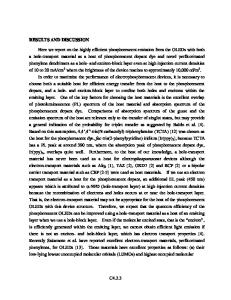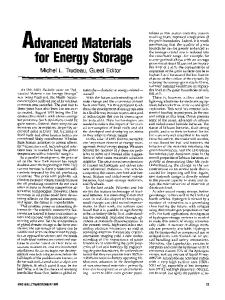Materials for Advanced Flywheel Energy-Storage Devices
- PDF / 2,135,087 Bytes
- 6 Pages / 604.8 x 806.4 pts Page_size
- 63 Downloads / 395 Views
Materials for Advanced Flywheels High-Performance Fibers
Background Flywheels are mechanical devices that Store kinetic energy in a rotating mass. A simple example is the potter's wheel. For energy storage and conversion, an efficient method to exchange energy with a flywheel device is by Converting the en ergy between mechanical and electrical forms. Typically a flywheel designed to perform this type of energy exchange is a combination of a motor and a generator. Energy is transferred into the device for storage by using it as a motor to consume electrical energy and spin the mass. This energy can be recovered with an efficiency exceeding 80% by using the flywheel as an electrical generator. Although the concept of storing energy in a rotating mass is an ancient idea, the relatively recent advent of advanced fibercomposite materials offers the potential for improved energy storage and con version using rotating electromechanical devices. The achievable energy density (energy/ weight) of a simple flywheel design, such as that shown schematically in Figure 1, is proportional to the specific strength (strength/density) of the material. The particular type of composite flywheel shown in this figure is composed entirely of circumferentially wrapped fiber. Although other designs have been suggested and constructed, this version is the most common for energy-storage applications. As discussed in the earliest papers on the subject, such as the article by Post and Post, 1 the proportionality between energy density and specific
MRS BULLETIN/NOVEMBER 1999
durability of the flywheel materials and structures is needed. The class of materials known as fiber composites encompasses a wide variety of material types and forms. Their com mon feature is the combination of highstrength a n d / o r h i g h - m o d u l u s fibers bound together by a matrix material. This article discusses the specific case of continuous fibers in a polymeric matrix, which offers the highest specific strengths. The strengths of high-performance fibers are compared. However, differences in the translation of material strength into the flywheel structure, as well as longterm Performance, can be overriding concerns, and bothof these are discussed. Additionally, some flywheel design modifications that compensate for weak m a t r i x - d o m i n a t e d failure modes are examined.
strength favors the use of fiber composites. The remarkable combination of mechanical properties and low density achieved with fiber composites has made them attractive and nearly essential for aerospace applications. Unlike these applications, which are driven primarily by a high stiffness-to-weight ratio, flywheels require a combination of high tensile strength and low density. The tradeoff between maximizing the energy-storage capability and establishing safe operating limits is probably the single most critical design problem in commercial flywheel applications. To overcome this problem, a complete understanding of the failure mechanisms and long-term
Circumferential
Fi
Data Loading...










